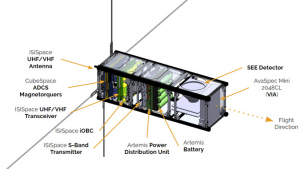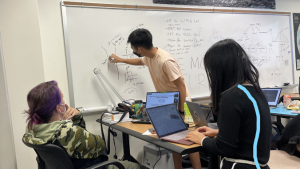
A University of Hawaiʻi at Mānoa student-led team was selected to develop a small research satellite for the NASA CubeSat Launch Initiative (CSLI) planned to launch between 2024–2027. UH’s proposed CubeSat is one of eight across the nation that will launch aboard planned missions led by NASA. The CubeSats will deploy into orbit from either a rocket or the International Space Station.
Students enrolled in the earth and planetary exploration technology (EPET) certificate based in UH’s Hawaiʻi Institute of Geophysics and Planetology (HIGP) have already completed the CubeSat design and many of the spacecraft parts are already in the laboratory and tested. This year the team will complete the science payload instruments, and in 2024 they will build the spacecraft, integrate the payload, test the entire assembly and get it ready for delivery to the launch provider by the end of the year.

“Having NASA’s CSLI program accept our mission is a huge opportunity that all of us have been working really hard towards,” said James Crawford, a junior majoring in Earth science. “Not only does it validate our continued efforts across the [Variability in Atmosphere from Solar Energetic Events Study] VIA-SEEs team, but it also speaks volumes to the quality of the EPET program and the faculty who help us everyday along this journey.”
NASA selected student-led and managed space exploration projects for launch into Earth orbit based on the quality of the proposed science and technical feasibility of the proposed spacecraft to be built and to complete the science investigation.
“I never expected that I would be able to join a professional research project during my college life,” said Yan Shan Liu, a senior majoring in chemistry. “I am grateful for the opportunity to study under Dr. [Peter] Englert. He inspires me to explore space chemistry; an area I never would have thought to pursue.”
EPET offers student-managed projects

The EPET program provides top-of-the-line professional education in space science and engineering. Students learn how to design and build science payloads, design science missions into space and design and build spacecraft that will be launched and operated in space to obtain new scientific results.
“The program gives undergraduate students an opportunity to engage in student-led and managed research projects,” said Englert, a professor in HIGP. “It teaches teamwork and the success suggests that the program could become a model for other areas. This is important for Hawaiʻi in that our students can now study space science and engineering at our state’s research university, and with that become part of the growing Hawaiʻi space work force.”
Completing the EPET/ME [Mechanical Engineering] program delivers more than lecture and laboratory based learning. The program is completed in addition to a major and provides science, engineering and management majors with focus studies and a certificate or concentration that qualifies them to join the space workforce.
“It is a great achievement underlining the students hard and innovative work, highlighting that they studied/learned space science and engineering well through the four course sequence, and that the EPET/ME program (and its instructors) teach the right stuff,” added Englert.
The original team members who have completed the course will recruit new members for the fall 2023 EPET/ME 301 class. The augmented team will complete and deliver the spacecraft in December 2024.
Students interested in the EPET/ME program who want to participate can enroll. To be admitted, interested students should contact Englert at penglert@hawaii.edu.

